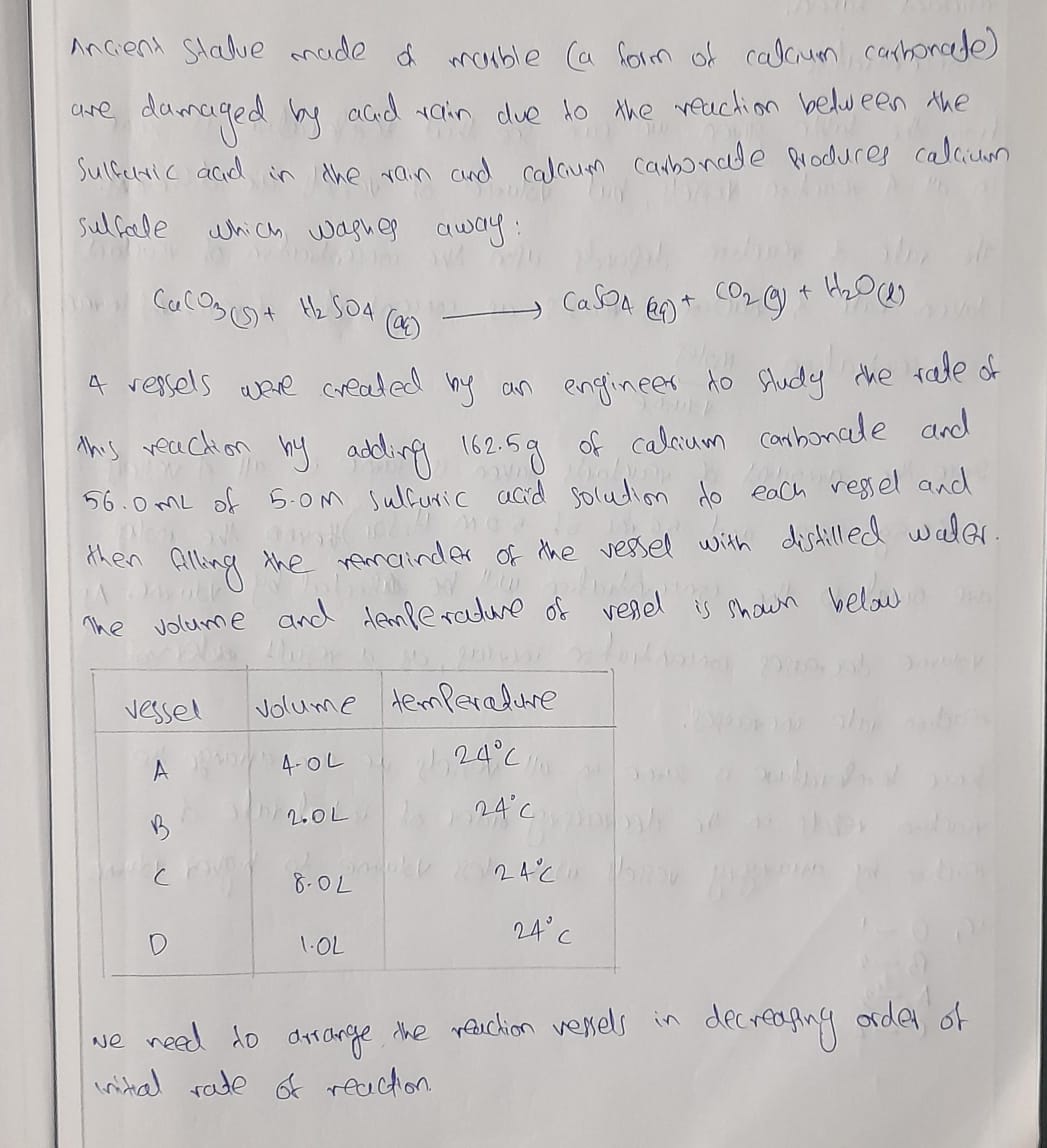Ancient statues made of marble (a form of calcium carbonate) are damaged by acid rain because the reaction between the sulfuric acid in the rain and calcium carbonate produces soluble calcium sulfate, which washes away: CaCO3(s)+H₂SO4 (aq) CaSO4 (aq) + CO₂(g)+H₂O(1) Suppose an engineer decides to study the rate of this reaction. She prepares four reaction vessels by adding 162.5 g of solid calcium carbonate and 56. mL of 5.0 M sulfuric acid solution to each, and then filling the remainder of the vessel with distilled water. The volume and temperature of each vessel is shown in the table below. Arrange the reaction vessels in decreasing order of initial rate of reaction. In other words, select a "1" next to the vessel in which the engineer can reasonably expect the initial rate of reaction to be highest, a "2" next to the vessel in which the initial rate of reaction would be next highest, and so on. vessel volume temperature पह B C D 4.0 L 2.0 L 8.0 L 1.0 L 24 °C 24. C 24. °C 24 °C initial rate of reaction ? 2 ? ? v v v ✓
Ancient statues made of marble (a form of calcium carbonate) are damaged by acid rain because the reaction between the sulfuric acid in the rain and calcium carbonate produces soluble calcium sulfate, which washes away: CaCO3(s)+H₂SO4 (aq) CaSO4 (aq) + CO₂(g)+H₂O(1) Suppose an engineer decides to study the rate of this reaction. She prepares four reaction vessels by adding 162.5 g of solid calcium carbonate and 56. mL of 5.0 M sulfuric acid solution to each, and then filling the remainder of the vessel with distilled water. The volume and temperature of each vessel is shown in the table below. Arrange the reaction vessels in decreasing order of initial rate of reaction. In other words, select a "1" next to the vessel in which the engineer can reasonably expect the initial rate of reaction to be highest, a "2" next to the vessel in which the initial rate of reaction would be next highest, and so on. vessel volume temperature पह B C D 4.0 L 2.0 L 8.0 L 1.0 L 24 °C 24. C 24. °C 24 °C initial rate of reaction ? 2 ? ? v v v ✓
Chemistry
10th Edition
ISBN:9781305957404
Author:Steven S. Zumdahl, Susan A. Zumdahl, Donald J. DeCoste
Publisher:Steven S. Zumdahl, Susan A. Zumdahl, Donald J. DeCoste
Chapter1: Chemical Foundations
Section: Chapter Questions
Problem 1RQ: Define and explain the differences between the following terms. a. law and theory b. theory and...
Related questions
Question

Transcribed Image Text:Ancient statues made of marble (a form of calcium carbonate) are damaged by acid rain because the reaction between the sulfuric acid in the rain and calcium
carbonate produces soluble calcium sulfate, which washes away:
CaCO3(s)+H₂SO4 (aq)
CaSO4 (aq)+CO₂(g) +H₂O(1)
Suppose an engineer decides to study the rate of this reaction. She prepares four reaction vessels by adding 162.5 g of solid calcium carbonate and 56. mL of
5.0 M sulfuric acid solution to each, and then filling the remainder of the vessel with distilled water. The volume and temperature of each vessel is shown in the
table below.
Arrange the reaction vessels in decreasing order of initial rate of reaction. In other words, select a "1" next to the vessel in which the engineer can reasonably
expect the initial rate of reaction to be highest, a "2" next to the vessel in which the initial rate of reaction would be next highest, and so on.
vessel volume temperature
B
C
D
4.0 L
2.0 L
8.0 L
1.0 L
24 °C
→
24. °C
24. °C
24 °C
initial rate of
reaction
2
?
?
Fot
?
3
v
v
v
Expert Solution
Step 1: Variables given

Trending now
This is a popular solution!
Step by step
Solved in 3 steps with 3 images

Knowledge Booster
Learn more about
Need a deep-dive on the concept behind this application? Look no further. Learn more about this topic, chemistry and related others by exploring similar questions and additional content below.Recommended textbooks for you

Chemistry
Chemistry
ISBN:
9781305957404
Author:
Steven S. Zumdahl, Susan A. Zumdahl, Donald J. DeCoste
Publisher:
Cengage Learning

Chemistry
Chemistry
ISBN:
9781259911156
Author:
Raymond Chang Dr., Jason Overby Professor
Publisher:
McGraw-Hill Education

Principles of Instrumental Analysis
Chemistry
ISBN:
9781305577213
Author:
Douglas A. Skoog, F. James Holler, Stanley R. Crouch
Publisher:
Cengage Learning

Chemistry
Chemistry
ISBN:
9781305957404
Author:
Steven S. Zumdahl, Susan A. Zumdahl, Donald J. DeCoste
Publisher:
Cengage Learning

Chemistry
Chemistry
ISBN:
9781259911156
Author:
Raymond Chang Dr., Jason Overby Professor
Publisher:
McGraw-Hill Education

Principles of Instrumental Analysis
Chemistry
ISBN:
9781305577213
Author:
Douglas A. Skoog, F. James Holler, Stanley R. Crouch
Publisher:
Cengage Learning

Organic Chemistry
Chemistry
ISBN:
9780078021558
Author:
Janice Gorzynski Smith Dr.
Publisher:
McGraw-Hill Education

Chemistry: Principles and Reactions
Chemistry
ISBN:
9781305079373
Author:
William L. Masterton, Cecile N. Hurley
Publisher:
Cengage Learning

Elementary Principles of Chemical Processes, Bind…
Chemistry
ISBN:
9781118431221
Author:
Richard M. Felder, Ronald W. Rousseau, Lisa G. Bullard
Publisher:
WILEY